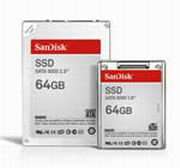SanDisk Launches 64 Gigabyte Solid State Drives for Notebooks

Reaching for the “sweet spot” of memory storage for laptop computers, SanDisk today expanded its line of solid state drive products with the introduction of a 64-gigabyte (GB) SSD aimed at both enterprise users and early adopter consumers such as gamers.
SanDisk 1.8-inch UATA 5000 and 2.5-inch SATA 5000 SSD products, which already are available in a 32GB capacity, are compatible as drop-in replacements for hard disk drives in most mainstream notebook computers.
The announcement was made at Computex Taipei 2007, where SanDisk is showcasing its comprehensive line of storage products for use in industrial and system-level embedded applications.
“Laptop manufacturers have requested more memory capacity for systems that use the Microsoft Vista platform, which can require a number of preloaded accessories and security suites,” said Doreet Oren, SanDisk director of SSD product marketing. “Also, there is interest in developing laptops for gaming, and the SSD is well-suited for the performance and memory requirements of those users. Thus, by offering greater capacities on our SSD products, we are making our products more appealing to a wider customer base.”
Compared to conventional hard drives still found in most notebook computers, SanDisk SSDs offer key benefits to computer manufacturers and their customers:
-- Durability and reliability. SanDisk SSDs deliver 2 million hours mean time between failures (MTBF), approximately six times more than notebook hard disks. With no moving parts, SanDisk SSDs are also much less likely to fail when a notebook computer is dropped or exposed to extreme temperatures.
-- High performance. With no moving parts, the flash-based SSD starts working almost immediately to achieve far better access speeds than a conventional hard disk drive. For example, in notebook computers, data moves to and from an SSD more than 100 times faster than data moving to and from a hard disk. SanDisk SSDs offer a sustained read rate of 67 megabytes (MB) per second and a random read rate of 7,000 inputs/outputs per second (IOPS) for a 512-byte transfer. As a result, notebooks equipped with a 2.5-inch SanDisk SSD can boot Microsoft Windows Vista Enterprise in as little as 30 seconds and access files at an average speed of 0.11 milliseconds. A notebook using a hard disk requires an average 48 seconds to boot and an average 17 milliseconds to access files.
-- Low power consumption. Compared to a typical hard disk drive, which consumes 1.9 watts during active operation, SanDisk SSDs consume 1.0 watt (0.5 watts for 1.8") while active and as little as 0.4 watts (0.2 watts for 1.8") while idle. This difference in power efficiency is particularly important in extending battery life for road warriors, enabling them to remain productive while in transit.
Gartner projects global consumption of SSDs in consumer and business notebooks to leap from about 4 million units in 2007 to 32 million units in 2010.
SanDisk SSD products are available now to manufacturers. The company plans to offer 64GB engineering samples in the third quarter, with mass production planned to commence prior to the end of the year.
Source: SanDisk





















